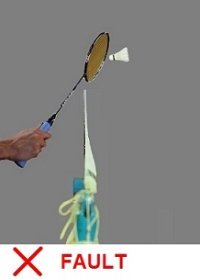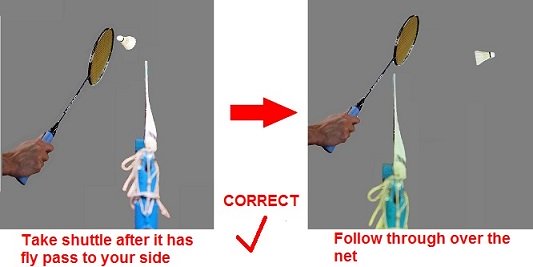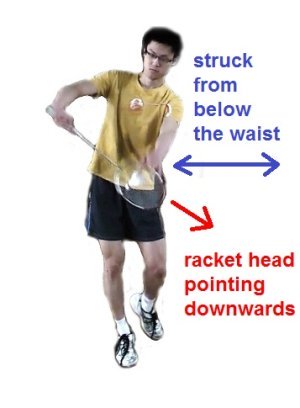Badminton Fouls
These are the 5 common badminton fouls that a player could commit in a badminton game.
1. Contact Fault
2. Over the Net Fault
3. Service Fault
4. Receiver Fault
5. Double Hit
If you are interested in the “strict” fouls during a professional badminton tournament, you may see this site for the complete set of rules
What is the penalty for a fault?
You lose the rally and your opponent will be awarded with ONE point.
So make sure you understand these common fouls to avoid losing unnecessary points to your opponent.
1. Contact Fault
When a rally is in play, this means when a serve has been delivered, there are TWO things that you cannot touch during the rally.
- Badminton Net. You and your racket cannot touch the net in the middle of a rally.
- Shuttlecock. You can hit the shuttle with the racket only. But you or any part of your body cannot touch the shuttle in the middle of a rally. Even if the shuttle touches your shirt, pants, leg, etc, it is still a contact fault.
2. Over the Net Fault
Of the 5 badminton fouls, I find that many people get confuse with this rule.
Can your racket go over the net in the middle of a rally?
The answer is Yes, it can go over the net. The next part is important…
BUT you are not allowed to take the shuttle before it passes the net to your side of the court.
I’ll show you 2 scenarios…
Scenario 1 – FAULT

FAULT because I take the shuttle when it’s still on my opponent’s side.
I can only take the shuttle after it has fly over to my side.
Scenario 2 – Correct (No Fault)

Not a fault because I take the shuttle after it crosses the net.
I am also allowed to follow through with my racket after I hit the shuttle. Even if my racket crosses over to my opponent’s side, it is fine.
To sum things up, you are NOT allowed to take the shuttle when it’s still on your opponent’s side. As long as you obey this, your racket can go over the net.
3. Service Fault
When you are delivering a service, be aware of the possible badminton fouls and try to avoid it.
Service faults often happen when you perform the low serve.
It’s even more commonly committed when you perform the low serve and flick serve in a doubles game. This is because players will try very hard to make their serve pass right above the net. It may sound simple but it’s definitely not an easy task for short players.
Ok the official rules may look complicated but I’ll simplify it for you. To avoid a service fault when serving:
- The shuttle must be struck from below your waist (lowest rib bone).
- Your racket head must be pointing at a downward direction when you hit the shuttle.
- Your racket must swing in an upward direction.

Sometimes it is difficult to detect whether a player obeyed the 3 conditions above. However there is an unofficial way to determine whether a service fault is committed.
If your serve is legal, there is NO way that you can hit a low serve that looks like a drive… unless your waist line is as high as the top of the net!
4. Receiver Fault
This one’s pretty straight forward.
When receiving a serve from your opponent, you cannot move your feet away from where you’re standing.
Otherwise it’s a receiver’s fault. You can only move after your opponent has struck the shuttle.
5. Double Hit
When the shuttle comes to your side, you have only ONE attempt to hit the shuttle.
Once your racket makes contact with the shuttle, you cannot hit it again until your opponent returns the shot.
In doubles: Only one player in a partnership is allowed to hit the shuttle. If both players touch the shuttle with their racket, it’s a double hit.
Back from Badminton Fouls to Badminton Rules
Please Like me on Facebook. Thanks!

Tell me what you think!
What do you think about what you just read? Leave me a comment below.